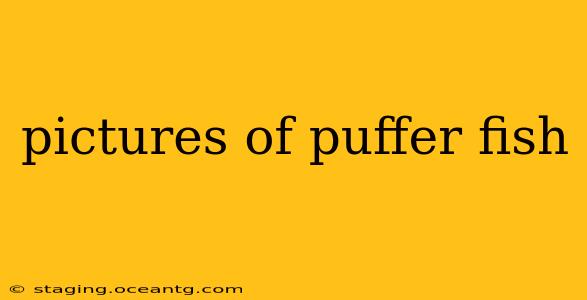Puffer fish, also known as blowfish, globefish, or balloonfish, are a group of approximately 120 species of fish belonging to the order Tetraodontiformes. Their unique ability to inflate their bodies into a ball-like shape when threatened is what makes them instantly recognizable and fascinating to observe. But there's much more to these intriguing creatures than just their defensive mechanism. This guide will explore the diverse world of puffer fish, showcasing their incredible variety and answering some frequently asked questions.
What are the different types of puffer fish?
There's an astonishing diversity within the puffer fish family. Some popular examples include:
-
The Japanese Pufferfish (Fugu): Renowned for its culinary significance (and extreme toxicity!), this species is a delicacy in Japan, requiring specially trained chefs to prepare it safely. Its distinctive features include a somewhat elongated body and a subtly patterned skin.
-
The Green Spotted Puffer: A vibrant and popular aquarium species, the Green Spotted Puffer is easily identified by its bright green spots against a lighter background. Their smaller size and relatively docile nature make them appealing to hobbyists.
-
The Porcupine Puffer: Distinguished by its longer spines and more robust build compared to other puffer species. These spines, like those of a hedgehog, are a significant deterrent to predators.
-
The Map Puffer: This species lives in the Indo-Pacific region and is popular in the aquarium trade, prized for its intricate and beautiful patterns that resemble a map.
These are just a few examples; the vast array of puffer fish species showcases a stunning range of colours, patterns, and sizes. Many are uniquely adapted to their specific environments.
Where do puffer fish live?
Puffer fish inhabit a wide range of marine and freshwater habitats across the globe. They are found in tropical and subtropical waters, from coral reefs to estuaries and even some freshwater rivers and lakes. Their distribution reflects their adaptability and diverse ecological niches.
Are puffer fish poisonous?
Yes, many species of puffer fish are highly poisonous. The toxin, tetrodotoxin (TTX), is one of the most potent neurotoxins known, and even a small amount can be fatal to humans. This toxicity is a crucial element of their defense mechanism. It's crucial to reiterate: never attempt to handle or consume puffer fish unless you are a trained professional.
What do puffer fish eat?
Puffer fish are opportunistic feeders with varied diets depending on their species and environment. Their diet often consists of:
- Crustaceans: Crabs, shrimp, and other shellfish are common prey.
- Mollusks: Snails, clams, and other mollusks provide essential nutrients.
- Algae: Some species consume algae, contributing to the maintenance of their aquatic ecosystems.
- Small fish: Larger puffer species may also consume smaller fish.
How big do puffer fish get?
The size of puffer fish varies greatly depending on the species. Some species remain relatively small, while others can grow to impressive sizes, exceeding 2 feet in length.
Can you keep puffer fish as pets?
While some smaller species of puffer fish are kept in aquariums, it's crucial to understand the demands of their care. A large, well-maintained tank with specific water parameters and a diverse diet is essential. Furthermore, many species require specialized care and knowledge to thrive. Thorough research is vital before acquiring a puffer fish as a pet. It's also important to check local regulations, as keeping certain species may be restricted.
Conclusion:
The world of puffer fish is fascinating and diverse, encompassing a wide range of species with unique characteristics and behaviors. Their ability to inflate, their potent toxicity, and their varied appearances make them a captivating subject of study and admiration. However, always remember to appreciate these creatures from a safe distance and respect their natural habitats. While pictures can showcase their beauty, responsible observation and conservation efforts are essential to protecting these remarkable animals.
